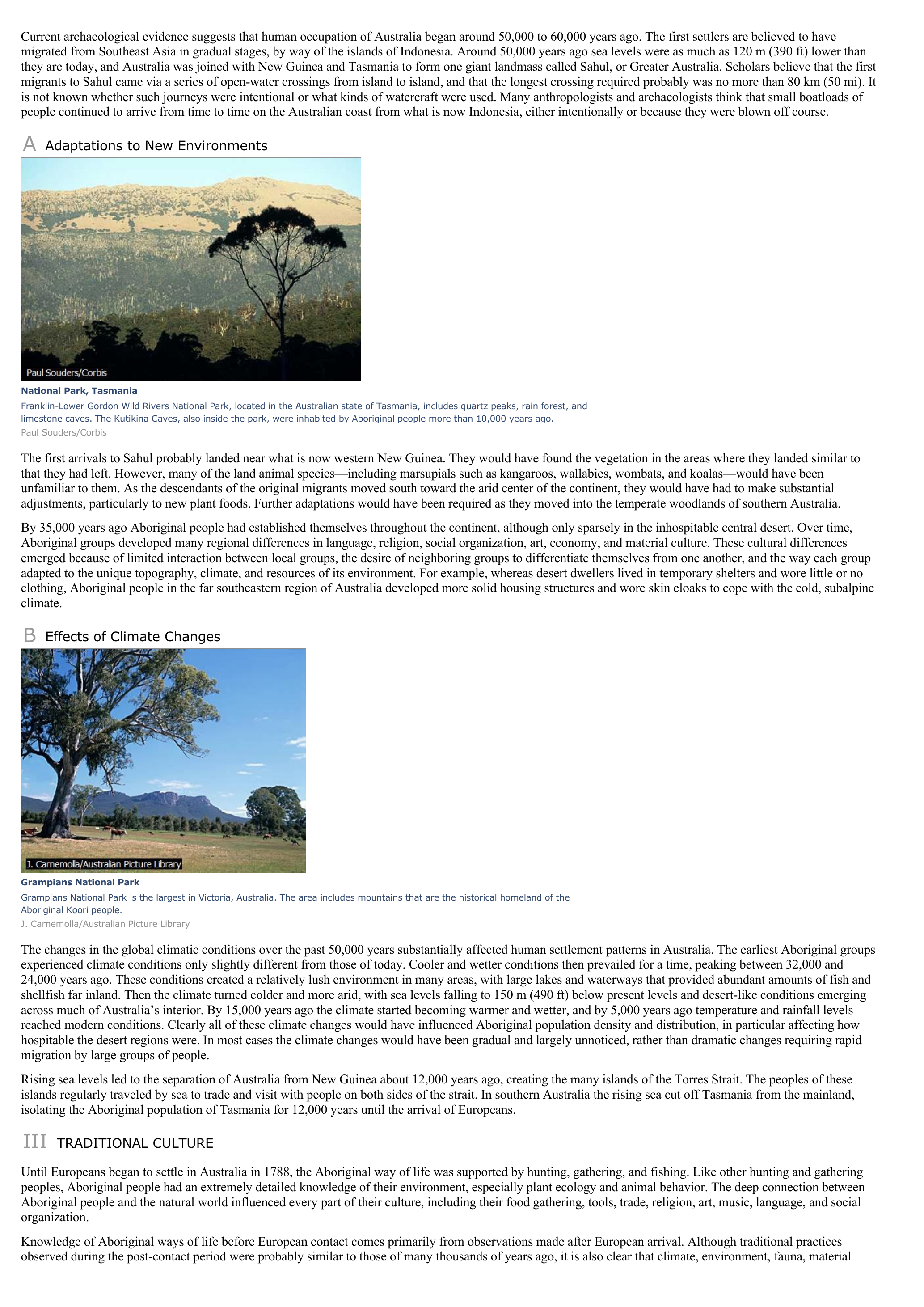Aboriginal Australians - history.
Publié le 26/05/2013

Extrait du document
«
Current archaeological evidence suggests that human occupation of Australia began around 50,000 to 60,000 years ago.
The first settlers are believed to havemigrated from Southeast Asia in gradual stages, by way of the islands of Indonesia.
Around 50,000 years ago sea levels were as much as 120 m (390 ft) lower thanthey are today, and Australia was joined with New Guinea and Tasmania to form one giant landmass called Sahul, or Greater Australia.
Scholars believe that the firstmigrants to Sahul came via a series of open-water crossings from island to island, and that the longest crossing required probably was no more than 80 km (50 mi).
Itis not known whether such journeys were intentional or what kinds of watercraft were used.
Many anthropologists and archaeologists think that small boatloads ofpeople continued to arrive from time to time on the Australian coast from what is now Indonesia, either intentionally or because they were blown off course.
A Adaptations to New Environments
National Park, TasmaniaFranklin-Lower Gordon Wild Rivers National Park, located in the Australian state of Tasmania, includes quartz peaks, rain forest, andlimestone caves.
The Kutikina Caves, also inside the park, were inhabited by Aboriginal people more than 10,000 years ago.Paul Souders/Corbis
The first arrivals to Sahul probably landed near what is now western New Guinea.
They would have found the vegetation in the areas where they landed similar tothat they had left.
However, many of the land animal species—including marsupials such as kangaroos, wallabies, wombats, and koalas—would have beenunfamiliar to them.
As the descendants of the original migrants moved south toward the arid center of the continent, they would have had to make substantialadjustments, particularly to new plant foods.
Further adaptations would have been required as they moved into the temperate woodlands of southern Australia.
By 35,000 years ago Aboriginal people had established themselves throughout the continent, although only sparsely in the inhospitable central desert.
Over time,Aboriginal groups developed many regional differences in language, religion, social organization, art, economy, and material culture.
These cultural differencesemerged because of limited interaction between local groups, the desire of neighboring groups to differentiate themselves from one another, and the way each groupadapted to the unique topography, climate, and resources of its environment.
For example, whereas desert dwellers lived in temporary shelters and wore little or noclothing, Aboriginal people in the far southeastern region of Australia developed more solid housing structures and wore skin cloaks to cope with the cold, subalpineclimate.
B Effects of Climate Changes
Grampians National ParkGrampians National Park is the largest in Victoria, Australia.
The area includes mountains that are the historical homeland of theAboriginal Koori people.J.
Carnemolla/Australian Picture Library
The changes in the global climatic conditions over the past 50,000 years substantially affected human settlement patterns in Australia.
The earliest Aboriginal groupsexperienced climate conditions only slightly different from those of today.
Cooler and wetter conditions then prevailed for a time, peaking between 32,000 and24,000 years ago.
These conditions created a relatively lush environment in many areas, with large lakes and waterways that provided abundant amounts of fish andshellfish far inland.
Then the climate turned colder and more arid, with sea levels falling to 150 m (490 ft) below present levels and desert-like conditions emergingacross much of Australia’s interior.
By 15,000 years ago the climate started becoming warmer and wetter, and by 5,000 years ago temperature and rainfall levelsreached modern conditions.
Clearly all of these climate changes would have influenced Aboriginal population density and distribution, in particular affecting howhospitable the desert regions were.
In most cases the climate changes would have been gradual and largely unnoticed, rather than dramatic changes requiring rapidmigration by large groups of people.
Rising sea levels led to the separation of Australia from New Guinea about 12,000 years ago, creating the many islands of the Torres Strait.
The peoples of theseislands regularly traveled by sea to trade and visit with people on both sides of the strait.
In southern Australia the rising sea cut off Tasmania from the mainland,isolating the Aboriginal population of Tasmania for 12,000 years until the arrival of Europeans.
III TRADITIONAL CULTURE
Until Europeans began to settle in Australia in 1788, the Aboriginal way of life was supported by hunting, gathering, and fishing.
Like other hunting and gatheringpeoples, Aboriginal people had an extremely detailed knowledge of their environment, especially plant ecology and animal behavior.
The deep connection betweenAboriginal people and the natural world influenced every part of their culture, including their food gathering, tools, trade, religion, art, music, language, and socialorganization.
Knowledge of Aboriginal ways of life before European contact comes primarily from observations made after European arrival.
Although traditional practicesobserved during the post-contact period were probably similar to those of many thousands of years ago, it is also clear that climate, environment, fauna, material.
»
↓↓↓ APERÇU DU DOCUMENT ↓↓↓
Liens utiles
- Aboriginal Australians - History.
- Ideology and Rationality in the History of the Life Sciences
- australia's aboriginal problem
- HISTOIRE DU RÈGNE DE L'EMPEREUR CHARLES-QUINT [The History of the Reign of the Emperor Charles V].
- HISTOIRE DU MONDE [History of the World].









